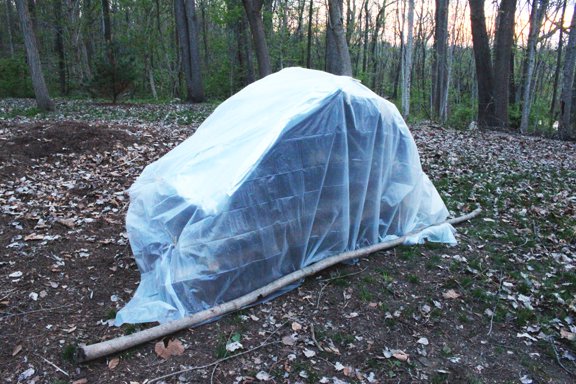The following is a quick tutorial on how to build a shelter using timber, boughs and plastic. This type of shelter can be constructed from materials you find all around you.
The only man made material used was plastic to weather proof it more than what the natural materials would allow; here are some steps to get started:
Step 1: Build the Frame
It is critical in cold weather to get off the ground. This can be done with a bed of leaves, boughs, limbs, or simply space between you and the ground. This shelter design starts with a framework that lifts the bed 12-18” off the ground to prevent the cold earth from sucking every ounce of heat from your body. It’s simply a log cabin-style box of sturdy logs. The inside cavity should be a few inches wider and longer than your body. Once they are cut and stacked, a jam knot lashing is used to secure the corners (I consider it one of the top 5 wilderness knots to know).
Once the “walls” are up, it’s time for a few cross-support beams. These are simply two or three 1-2” sturdy limbs placed between the walls. These can be moved forwards and backwards for comfort later. I like to place one behind my knees and one in my lower back, but you might prefer them elsewhere. These are not lashed into place.Step 2: Build the Bed
Many years ago I read an article written by a woman who grew up in the Appalachian Mountains and became an expert at making what were known as shuck beds. These were mattresses made from dried corn shucks. When sewing these shucks together, she would arrange them in a herringbone pattern and I have always taught my students to arrange their wilderness bedding in the same way. Mors Kochanski also teaches arranging your bedding in this style.
Step 3: The Dome Framework
Now it’s time to create a roof over your head. This is done in the form of a half-wigwam structure and should only take about 15-20 minutes to complete. I typically cut 10 saplings that are 8 feet long x 1 inch in diameter at the base. They need to be long, thin, and flexible. We used river cane when we built these shelters in the show and it worked like a dream. These saplings can either be wedged in the framework or stuck in the ground at the edge of the frame.
They need to be equally spaced all the way around. You start by bending the saplings at the head and foot of the bed toward the middle and then just twist them together. No rope or cordage is used …
This type of shelter is quick to construct, durable and will keep you safe from the elements. You may not want to stay a long time inside it, but over a long, cold night in a survival situation, it will feel like a bungalow on the beach.
Having a shelter also plays an immense part in keeping your morale up. Knowing you can be safe once inside and can get vital rest buoys your entire outlook on your situation.
To learn how to complete the shelter, head on over to The Art of Manliness to read the remaining steps.

Kool like sasquatch